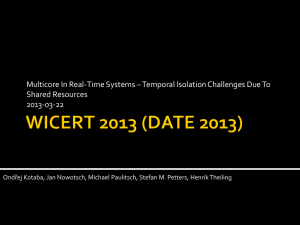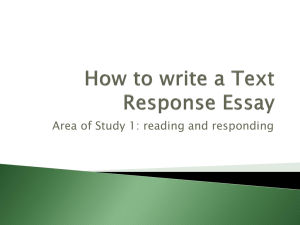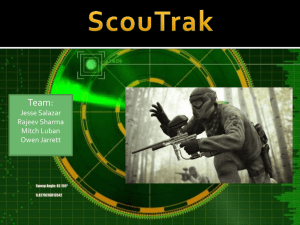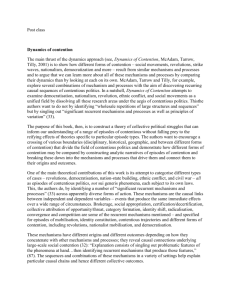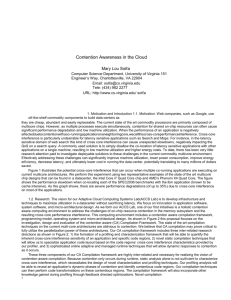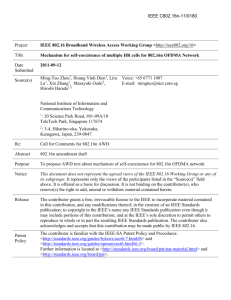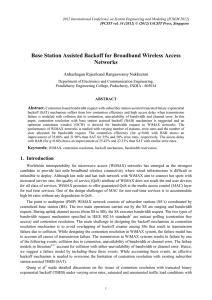Slides - Hong Kong University of Science and Technology
advertisement
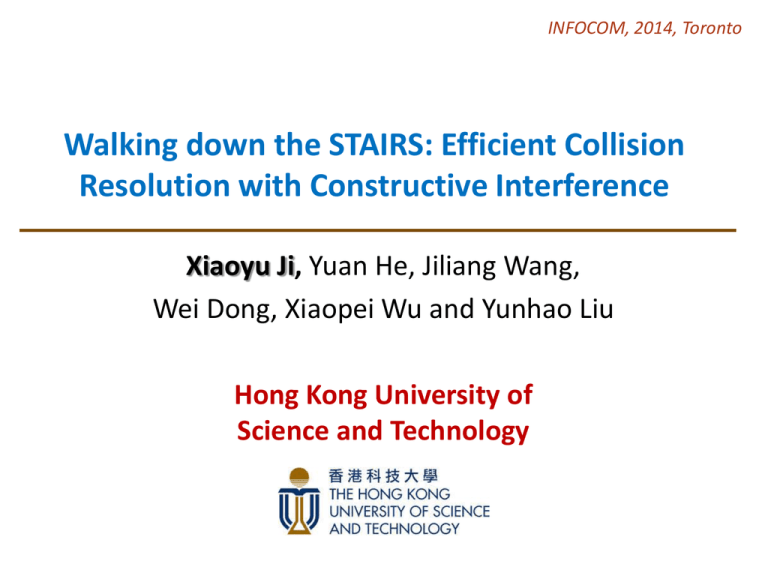
INFOCOM, 2014, Toronto Walking down the STAIRS: Efficient Collision Resolution with Constructive Interference Xiaoyu Ji, Yuan He, Jiliang Wang, Wei Dong, Xiaopei Wu and Yunhao Liu Hong Kong University of Science and Technology Motivation • Wireless Sensor Networks (WSNs) – Event-driven mode – Low duty cycle operating – Large number of nodes • CSMA-like protocols – Limitations – Backoff... 2 The Recent Art- COMA • COMA- Contend before data transmission – Contention packets reserve channel for real data packets – The drawback: dedicated contention packets in each round Collision Sender1 Sender2 Sender3 Receiver Contention Data Contention Data Contention Data Can we resolve the collision in just one round! DATA DATA 1 DATA DATA DATA 3 DATA DATA 2 DATA 1 DATA 2 DATA 3 Ref: F. Osterlind, et. al, Strawman: resolving collisions in bursty low-power wireless networks,” in IEEE/ACM IPSN, 2012 3 One-round Collision Resolution • The problem: – Count, identify and schedule – And of course in one round! • Approach – Active contention – Virtual ID – Fast identification 4 Our weapon: RSSI Stair Pattern • The observation – Signals can constructively collide – Requirements of Constructive Interference (CI) • 0.5 μs • Identical signal waveform 5 The Principle Proposition: Given the superposed signal CI(k) under CI, let A1 = A2 = … = A be the amplitude and τ1 = τ2= … = B denoting the phase offset with respect to the first signal generated by transmitter i = 1. Consider one IEEE 802.15.4 standard based communication system, RSSICI(k) is equal to: RSSI CI ( k ) k 20 log A i cos c i i 1 RSSI CI ( k ) CI ( k 1) 20 log10 Where ωc is a constant and τ1 =0 k , k 2 k 1 6 Design of STAIRS • Overview Period 2 Contention Period 1 Collision S1 D1 CR S2 D2 CR S3 D3 CR CP1 CP2 CP3 Period 3 Data transmission SP SP SP D D1 D2 SP SP SP D3 ... ... ... Data Contention CR Request Contention CP Packet Schedule SP Packet R CR SP D2 SP D1 SP D3 ... RSSI Value Time Through intentional contention, senders can be identified from the stair-like pattern of RSSI in one round. 7 Design Challenges • Challenge 1: Synchronization – Requirement of CI: Δ≤0.5μs • Challenge 2: Falling edge detection – CP packets with the same length – External interference, e.g., WiFi signals CP1 CP2 CP3 False falling edges (1) False negatives (2) False positives 8 Alignment for CP packets • Receiver-initiated (CR) – Triggering transmissions of CP packets – Serving as ACK/NACK – Coping with hidden terminals • Parallelizing receiving and reading 10 S-CUSUM Edge Detection • Discrete lengths of CP packets – Total sender number N, maximum packet size L, increase step ΔL, length of CP is: l CP L,2L,3L...mL • A paradox- how to find a good ΔL? Less false edges Larger CP space 10 • Finding the optimal ΔL – p=1/m: choose any of the m lengths – α: the probability of false positives • Three cases for a schedule: Pi (1 p ) N Ps Np (1 p ) N 1 Pc 1 Pi Ps Lopt arg max f Pi , Ps , Pc L 11 Implementation • STAIRS – A plug-in between APP and MAC layer – Invoked when collision happens – Three main components 12 Evaluation • Micro-benchmark – Synchronization – Edge detection • Multi-hop testbed – Completion time – Efficiency – Duty cycle • Large-scale simulation 13 Micro-benchmark • Offset among arriving packets less than 0.25 μs! • S-CUSUM increases detection efficiency. • Average detection accuracy is > 85%. 14 Testbed Settings • Multi-flow-multi-hop environment. • ΔL is set to 10 bytes. • 20 TelosB sensor nodes Flow number 15 Compared with Strawman • STAIRS beats Strawman, especially with large number of senders. • Contention overhead of STAIRS is amortized. 16 Duty Cycle Evaluation • Both sender and receiver duty cycles are improved, as contention time is reduced. • Energy efficiency is therefore improved. 17 Simulation • Settings – Up to 50 senders – Linear backoff (CSMA-L) – Exponential backoff (CSMA-E) 18 Results Pkt_size = 50 bytes Pkt_size = 100 bytes • No degraded performance • CSMA-L beats CSMA-E after the threshold • Backoff time dominates! 19 Summary • Collision resolution with active contention • Observing the RSSI stair-like pattern, we then look into its principle • Design STAIRS based on the stair pattern and solve challenges like synchronization and finding optimal ΔL • Evaluation in both real testbed and large-scale simulation 20 Thank you! 21
